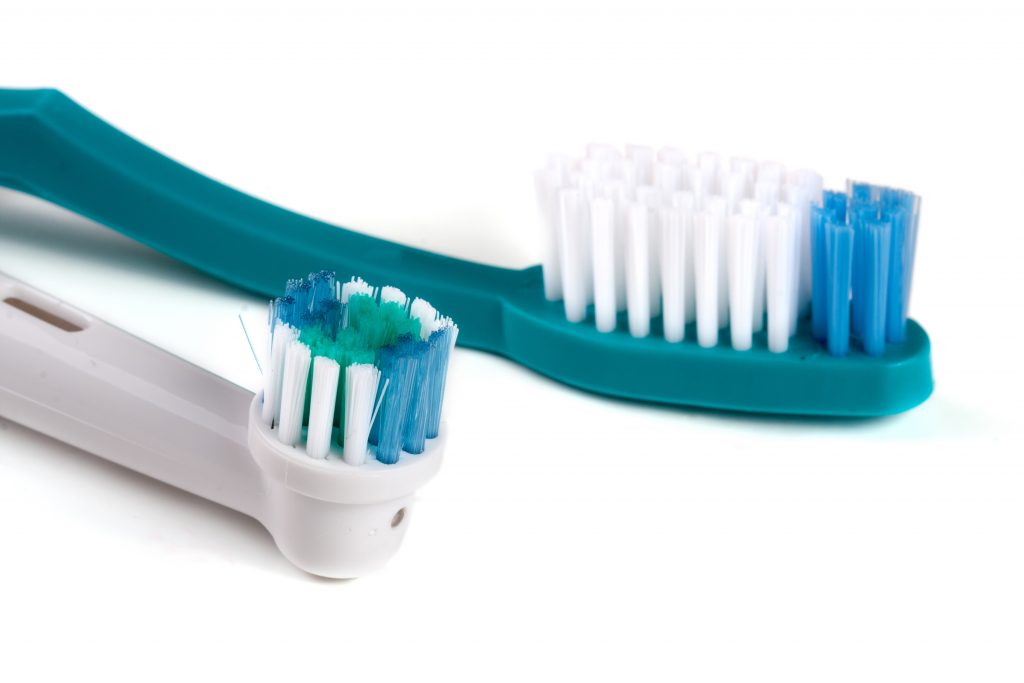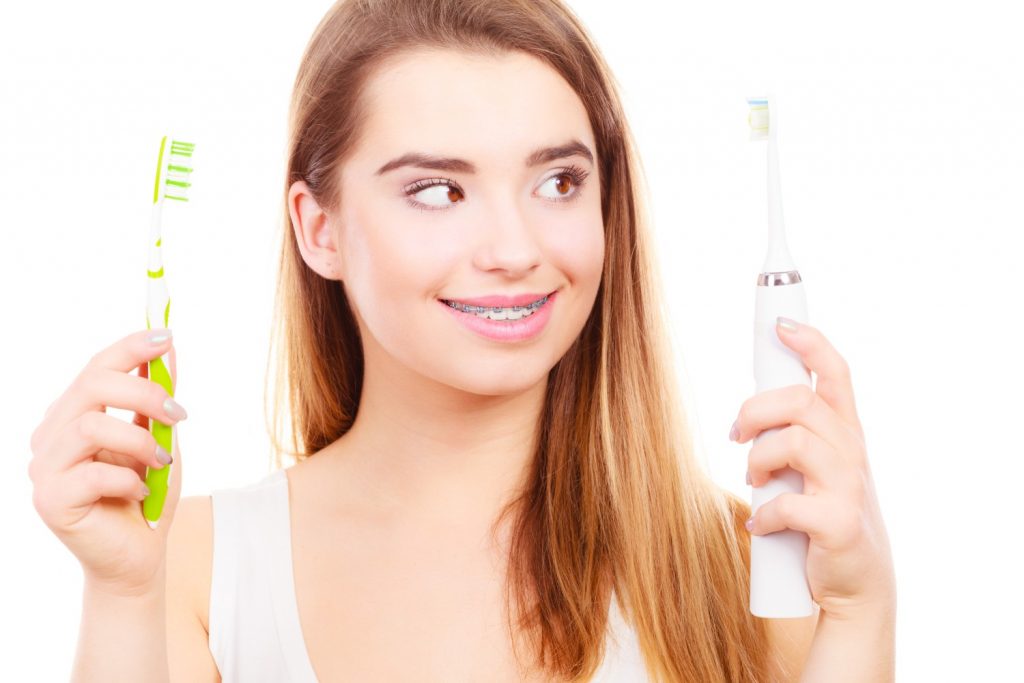Regular Toothbrush vs. Electric Toothbrush
- October 30, 2018

Here at Lincoln Orthodontics, we know it can be challenging to clean your teeth and gums thoroughly and effectively when you’re wearing braces. The brackets, wires, and bands can trap food particles, and they also create a series of nooks and crannies that can be hard to reach with a regular toothbrush. Yet brushing your teeth the right way is a critical component of oral care, and one every braces patient should take seriously.
If you’re a current orthodontic patient, you’re already aware of how important it is to maintain an effective oral hygiene routine. Brushing and flossing regularly keeps your teeth clean, your smile healthy, and also greatly reduces your chances of developing cavities and gum disease. Good dental hygiene helps remove any bacteria, residue, and food debris that can lead to a buildup of plaque acids and hardened tartar, thus increasing your risk of decay developing. Although it is easier to brush during aligner treatment, it is still critical to spend adequate time brushing and flossing to ensuring healthy teeth.
To keep these oral issues at bay, we encourage our patients to brush at least twice daily for two minutes (or more!), and floss every night before bed. While these are fairly simple habits to cultivate, choosing the best products to care for your braces can sometimes be a little more complicated!
What type of toothbrush should you choose as an orthodontic patient?
The oral care aisle of any store can be overwhelming given the sheer amount of choices on display. It seems like there’s a product for everything, from toothpaste for sensitive teeth to whitening gels, mouthwashes to flavored flosses, items designed specifically for orthodontic patients, manual and electric toothbrushes, and much more.
Most of these competing products are equally effective when it comes to caring for your teeth and gums, but it turns out that electric toothbrushes may actually have a slight edge over manual versions. This is especially true for orthodontic patients. In fact, one study by the American Journal of Orthodontics & Dentofacial Orthopedics found that an electric brush could remove a significantly greater amount of plaque than a manual one, which is good news for those wearing braces.
Of course, many of our patients can and do clean their teeth perfectly well with a manual toothbrush. However, some find electric brushes to be very beneficial. If you’re a current braces patient using a regular toothbrush in your dental hygiene routine, an electric toothbrush may be a better choice for your braces, teeth, and gums. Let’s take a closer look at the reasons why:
The advantages of an electric toothbrush
Multiple studies have shown that electric toothbrushes can be more effective than manual brushes at removing plaque. Some of the best models have even indicated an ability to remove up to 2x more total plaque, which is nothing to sneeze at! There are a number of factors that give these brushes an advantage over their manual counterparts, including:
Deep cleaning
Electric toothbrushes drive fluids in between the teeth, which means they’re able to get down deep and clean more effectively in and around the brackets and wires. Most models also produce hundreds or even thousands of movements per minute, something you can’t replicate with a manual toothbrush no matter how hard you try!
Custom cleaning modes
Many electric toothbrush models possess cleaning modes that have been customized with a specific purpose or issue in mind, such as sensitive teeth, whitening, stain removal, and much more.
Easy to use
Cleaning your teeth may seem like an easy task, but you’d be surprised to learn how many people get it wrong! Whether it’s rushing through the process or not understanding how to brush and floss properly, we’ve seen a number of patients over the years who just weren’t getting their gums and teeth clean. However, cavities and gum damage can often be avoided by doing nothing more than cleaning your mouth thoroughly and regularly. Electric toothbrushes can help you achieve this by removing the risk of “user error” by including timers, sensors, and multiple modes that most of the guesswork out of brushing.

Electric toothbrush features
Electric toothbrushes come with not only multiple modes, but in many different styles and with several different features as well. These can include:
Battery-powered options
Some electric brushes run on a simple AA or AAA battery. These are similar to manual toothbrushes, but have a head that spins or pulsates the bristles to add a little extra oomph to your brushing technique. Battery-powered toothbrushes will generally be the least expensive electric option, and can be very convenient. You should always be careful to replace the batteries as soon as they run out, though, in order to avoid acid leaks that can ruin the brush itself.
Rechargeable toothbrushes
These brushes will recharge using a base that plugs into a wall outlet, so there are no batteries to replace. These are the electric options that tend to offer the higher-tech options like timers, pressure sensors, and replacement reminders. They may also include a variety of brushing options, like oscillation or vibration.
Timers
Brushing for at least two minutes every time you brush is the standard, but it can be easy to miss this mark. One of the most common problems we see in patients is not brushing long enough, so the timers that some electric brushes include can be really helpful if you have trouble keeping your brushing on track. Some timers are even sophisticated enough to keep track of how long you’re meant to brush each quadrant of your mouth.
Pressure sensors
Some rechargeable brush models include a sensor that tracks the pressure you’re putting on your teeth that will alert you if you’re brushing too hard. This can be an especially helpful feature if you ever suffer from sensitive teeth or weak enamel.
Multiple brush heads
This feature allows you to switch detachable brush heads when the bristles wear out but keep the electric base of your toothbrush. While some bases will only fit one type of brush head, others are compatible with multiple types.
Multiple brush settings
There are some electric brushes that offer multiple settings for a more thorough cleaning experience, including:
- rotary, where the head rotates in only one direction
- counter-rotational, where the head rotates in various directions
- rotating-oscillating, which allows different lengths of bristles to rotate in opposite directions
- oscillating-pulsating, which adds a pulsating motion to the oscillatory motion
Lincoln Orthodontics: helping you brush your way to a beautiful smile
Whatever type of product you’re looking for to help take care of your braces and smile, we suggest sticking to ones that have the American Dental Association seal of approval. Products marked with the ADA seal have been studied thoroughly and tested for safety and effectiveness. They’re also guaranteed to perform as promised!
Our doctors recommend replacing your toothbrush or brush heads more often when you’re undergoing orthodontic treatment. Braces can be particularly hard on the bristles and they tend to wear out more quickly.

At Lincoln Orthodontics, our mission is to help you achieve not only a straighter smile, improved oral health across the board. Part of that is keeping your teeth and gums in good shape while you’re wearing braces. If you’d like to try incorporating an electric toothbrush into your oral hygiene routine, but aren’t sure where to start, Dr. Willett and Dr. Harre are happy to recommend one for you based on your specific case. Our dedicated team is always here to discuss any questions or concerns you have about your treatment plan! We want to give you the best experience possible on your orthodontic journey, and work hard to provide you with all the support you need throughout the process.


